Tuckman Model Analysis: Reflecting on Refugee Group Facilitation
VerifiedAdded on 2023/06/11
|11
|3342
|265
Report
AI Summary
This paper analyzes facilitation sessions with refugees using the Tuckman Model, reflecting on leadership styles and the facilitator's role. It describes the Tuckman Model's five stages (forming, storming, norming, performing, and adjourning) and applies them to different facilitation sessions. Session 1 focuses on sharing experiences and introductions (forming stage). Session 2 identifies support needs (storming stage), using storytelling to address initial reluctance. Later sessions use strength-based and narrative approaches to empower refugees, focusing on employment opportunities and psychological support (norming stage). The final session emphasizes self-sufficiency and peer support (performing stage), reflecting on the facilitator's role in enabling self-determination and collaborative problem-solving. The assignment highlights the importance of cultural sensitivity, ethical considerations, and continuous improvement in facilitation practices.
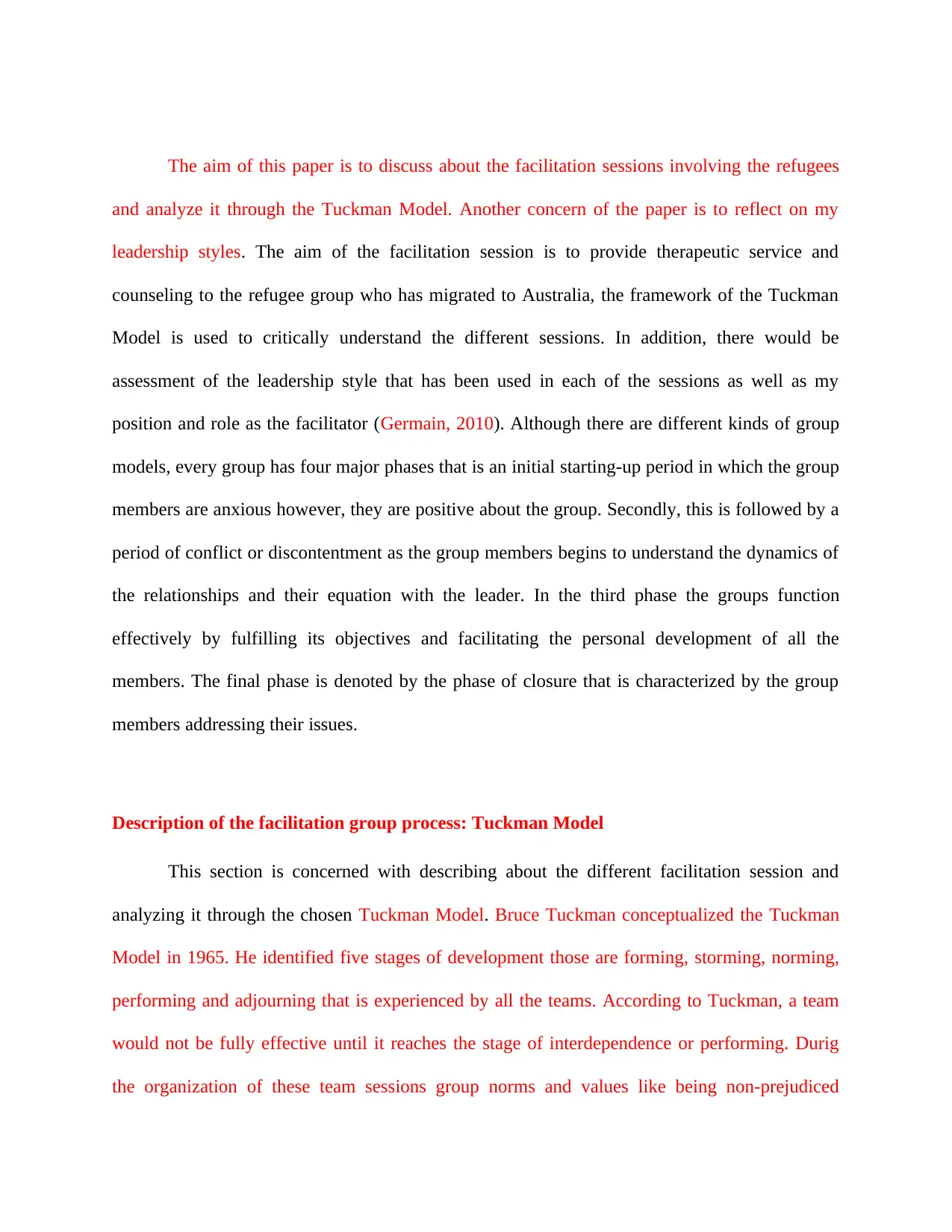
The aim of this paper is to discuss about the facilitation sessions involving the refugees
and analyze it through the Tuckman Model. Another concern of the paper is to reflect on my
leadership styles. The aim of the facilitation session is to provide therapeutic service and
counseling to the refugee group who has migrated to Australia, the framework of the Tuckman
Model is used to critically understand the different sessions. In addition, there would be
assessment of the leadership style that has been used in each of the sessions as well as my
position and role as the facilitator (Germain, 2010). Although there are different kinds of group
models, every group has four major phases that is an initial starting-up period in which the group
members are anxious however, they are positive about the group. Secondly, this is followed by a
period of conflict or discontentment as the group members begins to understand the dynamics of
the relationships and their equation with the leader. In the third phase the groups function
effectively by fulfilling its objectives and facilitating the personal development of all the
members. The final phase is denoted by the phase of closure that is characterized by the group
members addressing their issues.
Description of the facilitation group process: Tuckman Model
This section is concerned with describing about the different facilitation session and
analyzing it through the chosen Tuckman Model. Bruce Tuckman conceptualized the Tuckman
Model in 1965. He identified five stages of development those are forming, storming, norming,
performing and adjourning that is experienced by all the teams. According to Tuckman, a team
would not be fully effective until it reaches the stage of interdependence or performing. Durig
the organization of these team sessions group norms and values like being non-prejudiced
and analyze it through the Tuckman Model. Another concern of the paper is to reflect on my
leadership styles. The aim of the facilitation session is to provide therapeutic service and
counseling to the refugee group who has migrated to Australia, the framework of the Tuckman
Model is used to critically understand the different sessions. In addition, there would be
assessment of the leadership style that has been used in each of the sessions as well as my
position and role as the facilitator (Germain, 2010). Although there are different kinds of group
models, every group has four major phases that is an initial starting-up period in which the group
members are anxious however, they are positive about the group. Secondly, this is followed by a
period of conflict or discontentment as the group members begins to understand the dynamics of
the relationships and their equation with the leader. In the third phase the groups function
effectively by fulfilling its objectives and facilitating the personal development of all the
members. The final phase is denoted by the phase of closure that is characterized by the group
members addressing their issues.
Description of the facilitation group process: Tuckman Model
This section is concerned with describing about the different facilitation session and
analyzing it through the chosen Tuckman Model. Bruce Tuckman conceptualized the Tuckman
Model in 1965. He identified five stages of development those are forming, storming, norming,
performing and adjourning that is experienced by all the teams. According to Tuckman, a team
would not be fully effective until it reaches the stage of interdependence or performing. Durig
the organization of these team sessions group norms and values like being non-prejudiced
Secure Best Marks with AI Grader
Need help grading? Try our AI Grader for instant feedback on your assignments.
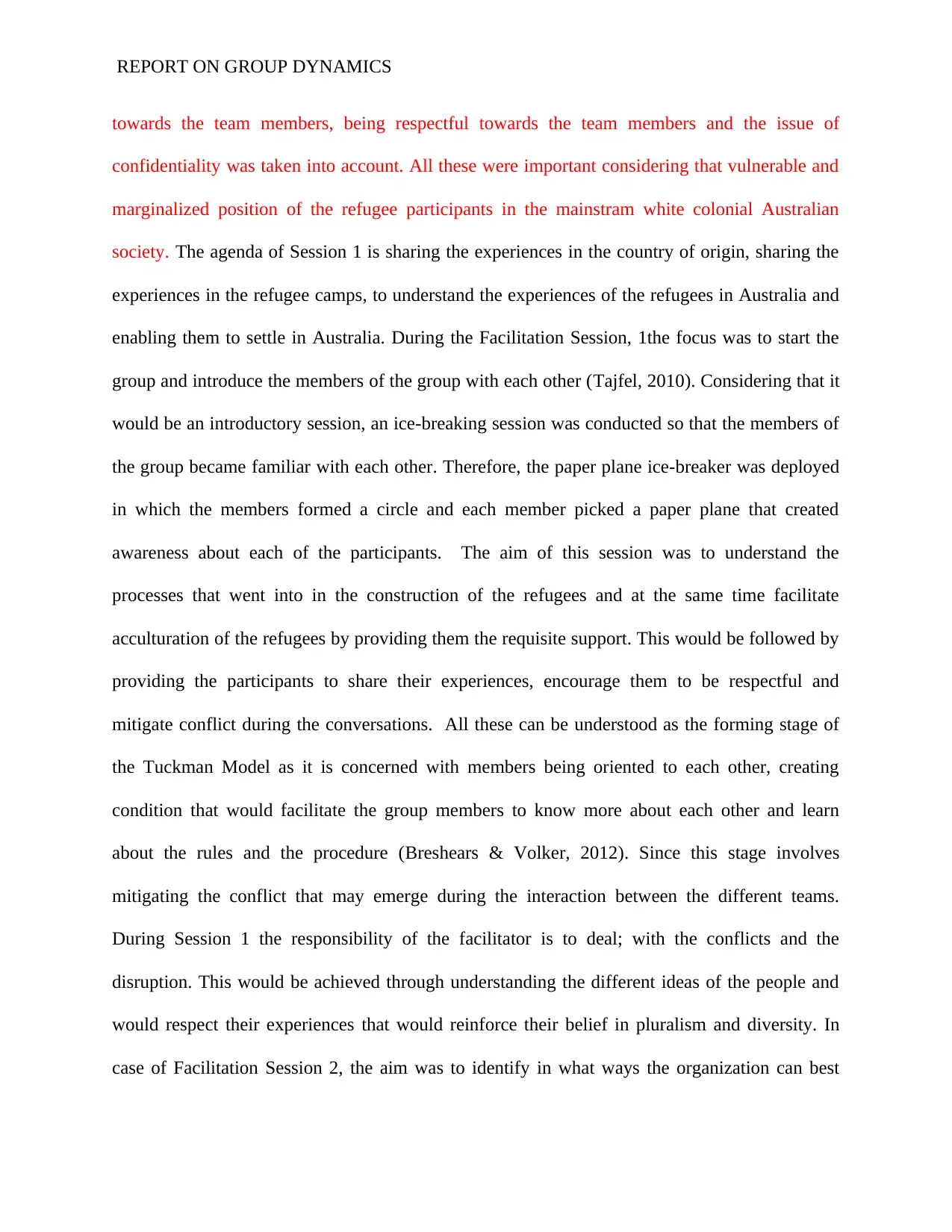
REPORT ON GROUP DYNAMICS
towards the team members, being respectful towards the team members and the issue of
confidentiality was taken into account. All these were important considering that vulnerable and
marginalized position of the refugee participants in the mainstram white colonial Australian
society. The agenda of Session 1 is sharing the experiences in the country of origin, sharing the
experiences in the refugee camps, to understand the experiences of the refugees in Australia and
enabling them to settle in Australia. During the Facilitation Session, 1the focus was to start the
group and introduce the members of the group with each other (Tajfel, 2010). Considering that it
would be an introductory session, an ice-breaking session was conducted so that the members of
the group became familiar with each other. Therefore, the paper plane ice-breaker was deployed
in which the members formed a circle and each member picked a paper plane that created
awareness about each of the participants. The aim of this session was to understand the
processes that went into in the construction of the refugees and at the same time facilitate
acculturation of the refugees by providing them the requisite support. This would be followed by
providing the participants to share their experiences, encourage them to be respectful and
mitigate conflict during the conversations. All these can be understood as the forming stage of
the Tuckman Model as it is concerned with members being oriented to each other, creating
condition that would facilitate the group members to know more about each other and learn
about the rules and the procedure (Breshears & Volker, 2012). Since this stage involves
mitigating the conflict that may emerge during the interaction between the different teams.
During Session 1 the responsibility of the facilitator is to deal; with the conflicts and the
disruption. This would be achieved through understanding the different ideas of the people and
would respect their experiences that would reinforce their belief in pluralism and diversity. In
case of Facilitation Session 2, the aim was to identify in what ways the organization can best
towards the team members, being respectful towards the team members and the issue of
confidentiality was taken into account. All these were important considering that vulnerable and
marginalized position of the refugee participants in the mainstram white colonial Australian
society. The agenda of Session 1 is sharing the experiences in the country of origin, sharing the
experiences in the refugee camps, to understand the experiences of the refugees in Australia and
enabling them to settle in Australia. During the Facilitation Session, 1the focus was to start the
group and introduce the members of the group with each other (Tajfel, 2010). Considering that it
would be an introductory session, an ice-breaking session was conducted so that the members of
the group became familiar with each other. Therefore, the paper plane ice-breaker was deployed
in which the members formed a circle and each member picked a paper plane that created
awareness about each of the participants. The aim of this session was to understand the
processes that went into in the construction of the refugees and at the same time facilitate
acculturation of the refugees by providing them the requisite support. This would be followed by
providing the participants to share their experiences, encourage them to be respectful and
mitigate conflict during the conversations. All these can be understood as the forming stage of
the Tuckman Model as it is concerned with members being oriented to each other, creating
condition that would facilitate the group members to know more about each other and learn
about the rules and the procedure (Breshears & Volker, 2012). Since this stage involves
mitigating the conflict that may emerge during the interaction between the different teams.
During Session 1 the responsibility of the facilitator is to deal; with the conflicts and the
disruption. This would be achieved through understanding the different ideas of the people and
would respect their experiences that would reinforce their belief in pluralism and diversity. In
case of Facilitation Session 2, the aim was to identify in what ways the organization can best
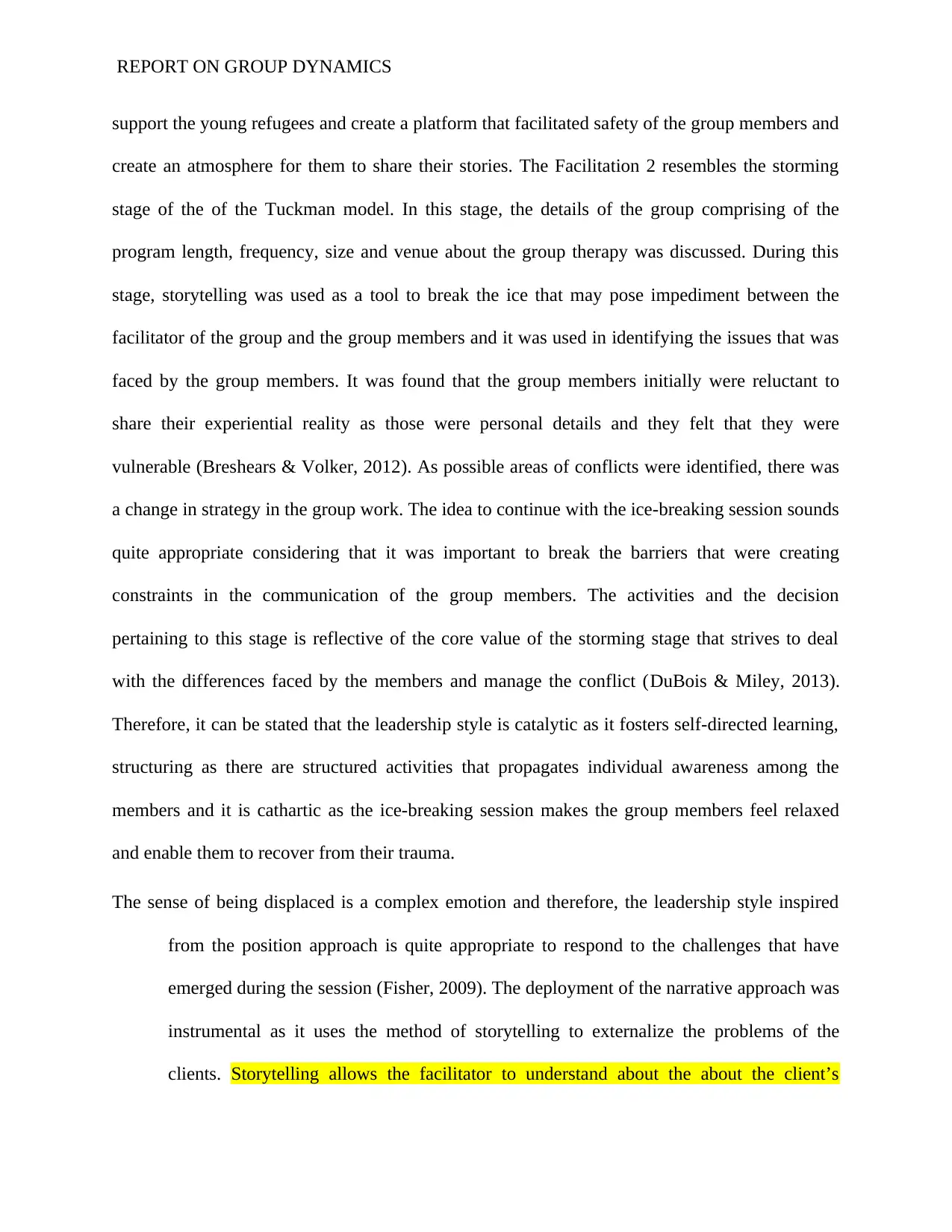
REPORT ON GROUP DYNAMICS
support the young refugees and create a platform that facilitated safety of the group members and
create an atmosphere for them to share their stories. The Facilitation 2 resembles the storming
stage of the of the Tuckman model. In this stage, the details of the group comprising of the
program length, frequency, size and venue about the group therapy was discussed. During this
stage, storytelling was used as a tool to break the ice that may pose impediment between the
facilitator of the group and the group members and it was used in identifying the issues that was
faced by the group members. It was found that the group members initially were reluctant to
share their experiential reality as those were personal details and they felt that they were
vulnerable (Breshears & Volker, 2012). As possible areas of conflicts were identified, there was
a change in strategy in the group work. The idea to continue with the ice-breaking session sounds
quite appropriate considering that it was important to break the barriers that were creating
constraints in the communication of the group members. The activities and the decision
pertaining to this stage is reflective of the core value of the storming stage that strives to deal
with the differences faced by the members and manage the conflict (DuBois & Miley, 2013).
Therefore, it can be stated that the leadership style is catalytic as it fosters self-directed learning,
structuring as there are structured activities that propagates individual awareness among the
members and it is cathartic as the ice-breaking session makes the group members feel relaxed
and enable them to recover from their trauma.
The sense of being displaced is a complex emotion and therefore, the leadership style inspired
from the position approach is quite appropriate to respond to the challenges that have
emerged during the session (Fisher, 2009). The deployment of the narrative approach was
instrumental as it uses the method of storytelling to externalize the problems of the
clients. Storytelling allows the facilitator to understand about the about the client’s
support the young refugees and create a platform that facilitated safety of the group members and
create an atmosphere for them to share their stories. The Facilitation 2 resembles the storming
stage of the of the Tuckman model. In this stage, the details of the group comprising of the
program length, frequency, size and venue about the group therapy was discussed. During this
stage, storytelling was used as a tool to break the ice that may pose impediment between the
facilitator of the group and the group members and it was used in identifying the issues that was
faced by the group members. It was found that the group members initially were reluctant to
share their experiential reality as those were personal details and they felt that they were
vulnerable (Breshears & Volker, 2012). As possible areas of conflicts were identified, there was
a change in strategy in the group work. The idea to continue with the ice-breaking session sounds
quite appropriate considering that it was important to break the barriers that were creating
constraints in the communication of the group members. The activities and the decision
pertaining to this stage is reflective of the core value of the storming stage that strives to deal
with the differences faced by the members and manage the conflict (DuBois & Miley, 2013).
Therefore, it can be stated that the leadership style is catalytic as it fosters self-directed learning,
structuring as there are structured activities that propagates individual awareness among the
members and it is cathartic as the ice-breaking session makes the group members feel relaxed
and enable them to recover from their trauma.
The sense of being displaced is a complex emotion and therefore, the leadership style inspired
from the position approach is quite appropriate to respond to the challenges that have
emerged during the session (Fisher, 2009). The deployment of the narrative approach was
instrumental as it uses the method of storytelling to externalize the problems of the
clients. Storytelling allows the facilitator to understand about the about the client’s
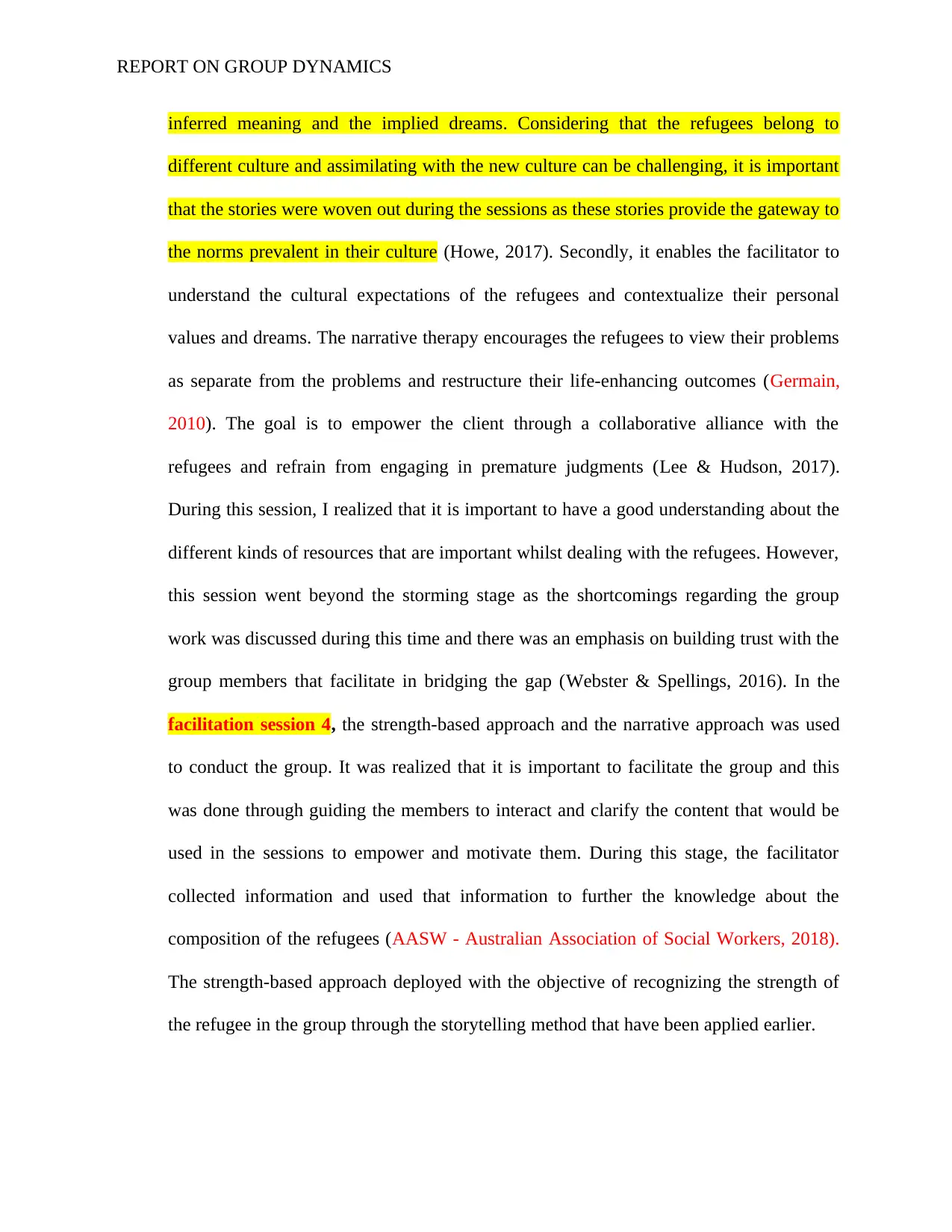
REPORT ON GROUP DYNAMICS
inferred meaning and the implied dreams. Considering that the refugees belong to
different culture and assimilating with the new culture can be challenging, it is important
that the stories were woven out during the sessions as these stories provide the gateway to
the norms prevalent in their culture (Howe, 2017). Secondly, it enables the facilitator to
understand the cultural expectations of the refugees and contextualize their personal
values and dreams. The narrative therapy encourages the refugees to view their problems
as separate from the problems and restructure their life-enhancing outcomes (Germain,
2010). The goal is to empower the client through a collaborative alliance with the
refugees and refrain from engaging in premature judgments (Lee & Hudson, 2017).
During this session, I realized that it is important to have a good understanding about the
different kinds of resources that are important whilst dealing with the refugees. However,
this session went beyond the storming stage as the shortcomings regarding the group
work was discussed during this time and there was an emphasis on building trust with the
group members that facilitate in bridging the gap (Webster & Spellings, 2016). In the
facilitation session 4, the strength-based approach and the narrative approach was used
to conduct the group. It was realized that it is important to facilitate the group and this
was done through guiding the members to interact and clarify the content that would be
used in the sessions to empower and motivate them. During this stage, the facilitator
collected information and used that information to further the knowledge about the
composition of the refugees (AASW - Australian Association of Social Workers, 2018).
The strength-based approach deployed with the objective of recognizing the strength of
the refugee in the group through the storytelling method that have been applied earlier.
inferred meaning and the implied dreams. Considering that the refugees belong to
different culture and assimilating with the new culture can be challenging, it is important
that the stories were woven out during the sessions as these stories provide the gateway to
the norms prevalent in their culture (Howe, 2017). Secondly, it enables the facilitator to
understand the cultural expectations of the refugees and contextualize their personal
values and dreams. The narrative therapy encourages the refugees to view their problems
as separate from the problems and restructure their life-enhancing outcomes (Germain,
2010). The goal is to empower the client through a collaborative alliance with the
refugees and refrain from engaging in premature judgments (Lee & Hudson, 2017).
During this session, I realized that it is important to have a good understanding about the
different kinds of resources that are important whilst dealing with the refugees. However,
this session went beyond the storming stage as the shortcomings regarding the group
work was discussed during this time and there was an emphasis on building trust with the
group members that facilitate in bridging the gap (Webster & Spellings, 2016). In the
facilitation session 4, the strength-based approach and the narrative approach was used
to conduct the group. It was realized that it is important to facilitate the group and this
was done through guiding the members to interact and clarify the content that would be
used in the sessions to empower and motivate them. During this stage, the facilitator
collected information and used that information to further the knowledge about the
composition of the refugees (AASW - Australian Association of Social Workers, 2018).
The strength-based approach deployed with the objective of recognizing the strength of
the refugee in the group through the storytelling method that have been applied earlier.
Secure Best Marks with AI Grader
Need help grading? Try our AI Grader for instant feedback on your assignments.
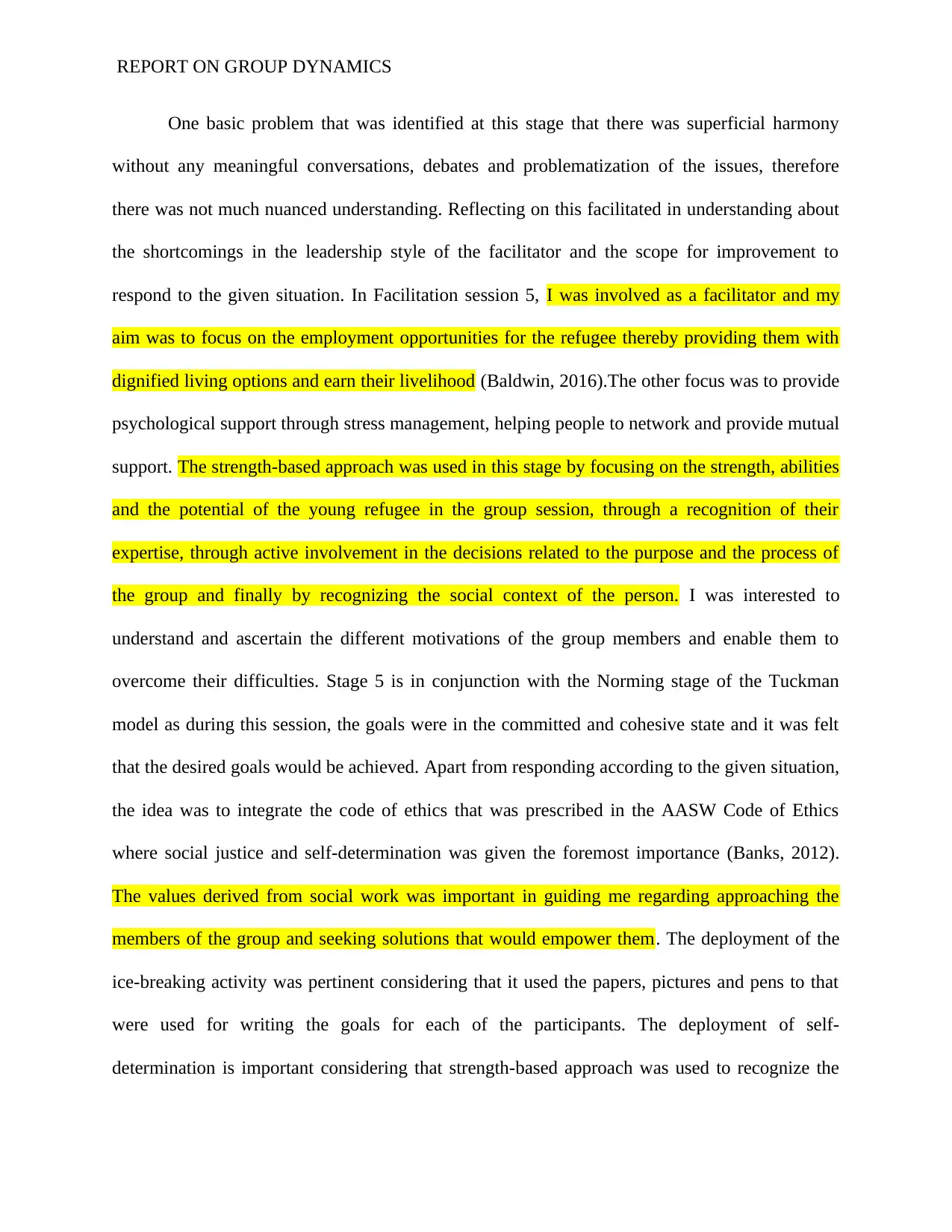
REPORT ON GROUP DYNAMICS
One basic problem that was identified at this stage that there was superficial harmony
without any meaningful conversations, debates and problematization of the issues, therefore
there was not much nuanced understanding. Reflecting on this facilitated in understanding about
the shortcomings in the leadership style of the facilitator and the scope for improvement to
respond to the given situation. In Facilitation session 5, I was involved as a facilitator and my
aim was to focus on the employment opportunities for the refugee thereby providing them with
dignified living options and earn their livelihood (Baldwin, 2016).The other focus was to provide
psychological support through stress management, helping people to network and provide mutual
support. The strength-based approach was used in this stage by focusing on the strength, abilities
and the potential of the young refugee in the group session, through a recognition of their
expertise, through active involvement in the decisions related to the purpose and the process of
the group and finally by recognizing the social context of the person. I was interested to
understand and ascertain the different motivations of the group members and enable them to
overcome their difficulties. Stage 5 is in conjunction with the Norming stage of the Tuckman
model as during this session, the goals were in the committed and cohesive state and it was felt
that the desired goals would be achieved. Apart from responding according to the given situation,
the idea was to integrate the code of ethics that was prescribed in the AASW Code of Ethics
where social justice and self-determination was given the foremost importance (Banks, 2012).
The values derived from social work was important in guiding me regarding approaching the
members of the group and seeking solutions that would empower them. The deployment of the
ice-breaking activity was pertinent considering that it used the papers, pictures and pens to that
were used for writing the goals for each of the participants. The deployment of self-
determination is important considering that strength-based approach was used to recognize the
One basic problem that was identified at this stage that there was superficial harmony
without any meaningful conversations, debates and problematization of the issues, therefore
there was not much nuanced understanding. Reflecting on this facilitated in understanding about
the shortcomings in the leadership style of the facilitator and the scope for improvement to
respond to the given situation. In Facilitation session 5, I was involved as a facilitator and my
aim was to focus on the employment opportunities for the refugee thereby providing them with
dignified living options and earn their livelihood (Baldwin, 2016).The other focus was to provide
psychological support through stress management, helping people to network and provide mutual
support. The strength-based approach was used in this stage by focusing on the strength, abilities
and the potential of the young refugee in the group session, through a recognition of their
expertise, through active involvement in the decisions related to the purpose and the process of
the group and finally by recognizing the social context of the person. I was interested to
understand and ascertain the different motivations of the group members and enable them to
overcome their difficulties. Stage 5 is in conjunction with the Norming stage of the Tuckman
model as during this session, the goals were in the committed and cohesive state and it was felt
that the desired goals would be achieved. Apart from responding according to the given situation,
the idea was to integrate the code of ethics that was prescribed in the AASW Code of Ethics
where social justice and self-determination was given the foremost importance (Banks, 2012).
The values derived from social work was important in guiding me regarding approaching the
members of the group and seeking solutions that would empower them. The deployment of the
ice-breaking activity was pertinent considering that it used the papers, pictures and pens to that
were used for writing the goals for each of the participants. The deployment of self-
determination is important considering that strength-based approach was used to recognize the
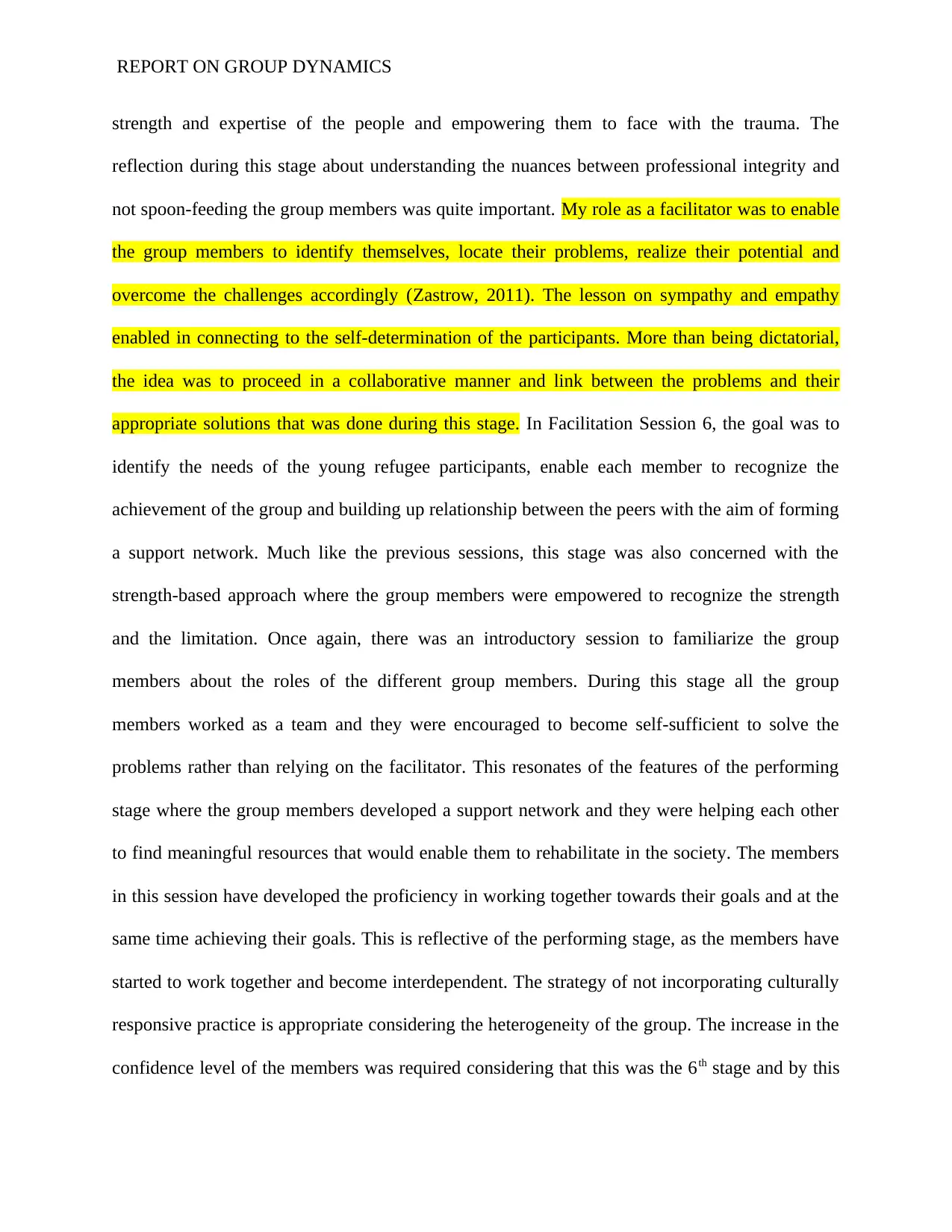
REPORT ON GROUP DYNAMICS
strength and expertise of the people and empowering them to face with the trauma. The
reflection during this stage about understanding the nuances between professional integrity and
not spoon-feeding the group members was quite important. My role as a facilitator was to enable
the group members to identify themselves, locate their problems, realize their potential and
overcome the challenges accordingly (Zastrow, 2011). The lesson on sympathy and empathy
enabled in connecting to the self-determination of the participants. More than being dictatorial,
the idea was to proceed in a collaborative manner and link between the problems and their
appropriate solutions that was done during this stage. In Facilitation Session 6, the goal was to
identify the needs of the young refugee participants, enable each member to recognize the
achievement of the group and building up relationship between the peers with the aim of forming
a support network. Much like the previous sessions, this stage was also concerned with the
strength-based approach where the group members were empowered to recognize the strength
and the limitation. Once again, there was an introductory session to familiarize the group
members about the roles of the different group members. During this stage all the group
members worked as a team and they were encouraged to become self-sufficient to solve the
problems rather than relying on the facilitator. This resonates of the features of the performing
stage where the group members developed a support network and they were helping each other
to find meaningful resources that would enable them to rehabilitate in the society. The members
in this session have developed the proficiency in working together towards their goals and at the
same time achieving their goals. This is reflective of the performing stage, as the members have
started to work together and become interdependent. The strategy of not incorporating culturally
responsive practice is appropriate considering the heterogeneity of the group. The increase in the
confidence level of the members was required considering that this was the 6th stage and by this
strength and expertise of the people and empowering them to face with the trauma. The
reflection during this stage about understanding the nuances between professional integrity and
not spoon-feeding the group members was quite important. My role as a facilitator was to enable
the group members to identify themselves, locate their problems, realize their potential and
overcome the challenges accordingly (Zastrow, 2011). The lesson on sympathy and empathy
enabled in connecting to the self-determination of the participants. More than being dictatorial,
the idea was to proceed in a collaborative manner and link between the problems and their
appropriate solutions that was done during this stage. In Facilitation Session 6, the goal was to
identify the needs of the young refugee participants, enable each member to recognize the
achievement of the group and building up relationship between the peers with the aim of forming
a support network. Much like the previous sessions, this stage was also concerned with the
strength-based approach where the group members were empowered to recognize the strength
and the limitation. Once again, there was an introductory session to familiarize the group
members about the roles of the different group members. During this stage all the group
members worked as a team and they were encouraged to become self-sufficient to solve the
problems rather than relying on the facilitator. This resonates of the features of the performing
stage where the group members developed a support network and they were helping each other
to find meaningful resources that would enable them to rehabilitate in the society. The members
in this session have developed the proficiency in working together towards their goals and at the
same time achieving their goals. This is reflective of the performing stage, as the members have
started to work together and become interdependent. The strategy of not incorporating culturally
responsive practice is appropriate considering the heterogeneity of the group. The increase in the
confidence level of the members was required considering that this was the 6th stage and by this
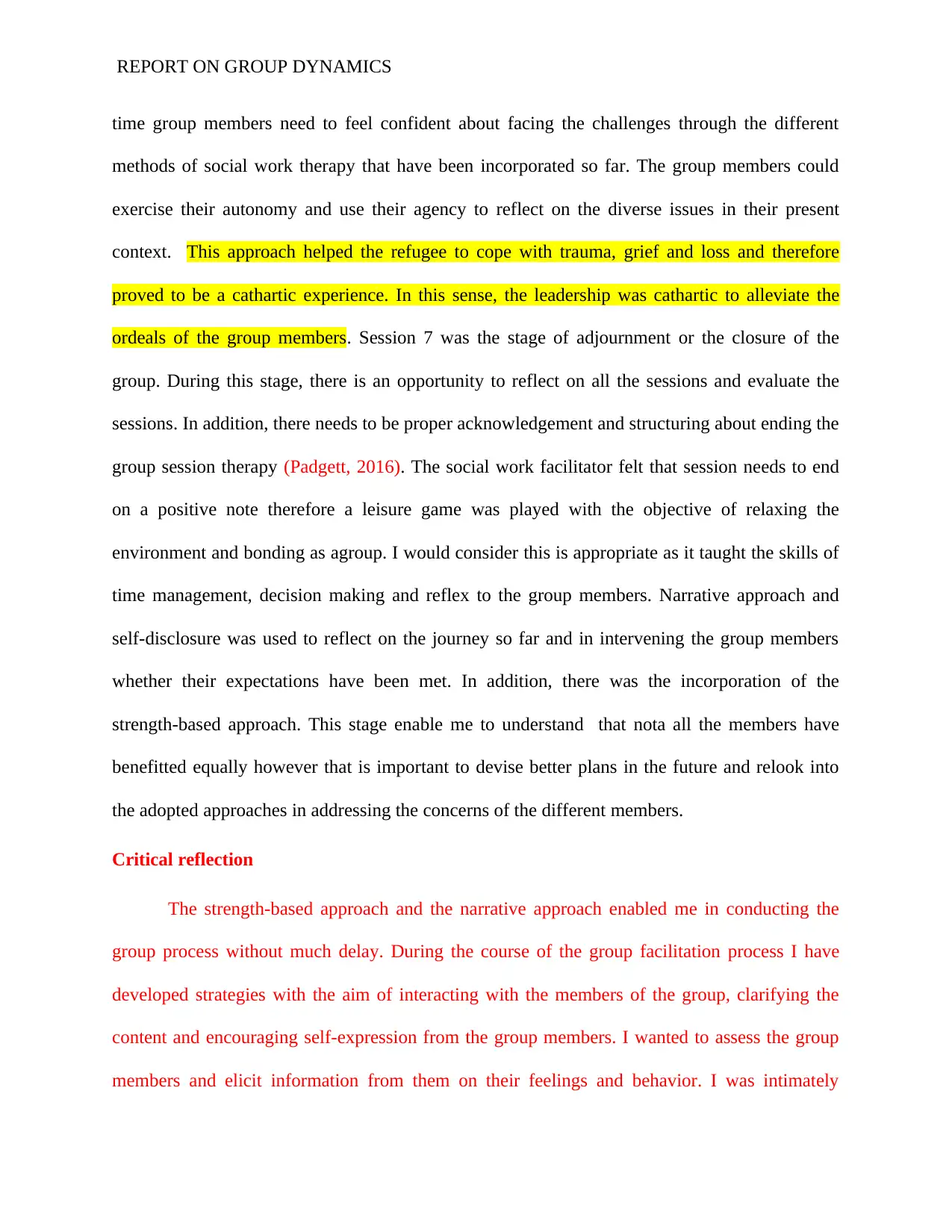
REPORT ON GROUP DYNAMICS
time group members need to feel confident about facing the challenges through the different
methods of social work therapy that have been incorporated so far. The group members could
exercise their autonomy and use their agency to reflect on the diverse issues in their present
context. This approach helped the refugee to cope with trauma, grief and loss and therefore
proved to be a cathartic experience. In this sense, the leadership was cathartic to alleviate the
ordeals of the group members. Session 7 was the stage of adjournment or the closure of the
group. During this stage, there is an opportunity to reflect on all the sessions and evaluate the
sessions. In addition, there needs to be proper acknowledgement and structuring about ending the
group session therapy (Padgett, 2016). The social work facilitator felt that session needs to end
on a positive note therefore a leisure game was played with the objective of relaxing the
environment and bonding as agroup. I would consider this is appropriate as it taught the skills of
time management, decision making and reflex to the group members. Narrative approach and
self-disclosure was used to reflect on the journey so far and in intervening the group members
whether their expectations have been met. In addition, there was the incorporation of the
strength-based approach. This stage enable me to understand that nota all the members have
benefitted equally however that is important to devise better plans in the future and relook into
the adopted approaches in addressing the concerns of the different members.
Critical reflection
The strength-based approach and the narrative approach enabled me in conducting the
group process without much delay. During the course of the group facilitation process I have
developed strategies with the aim of interacting with the members of the group, clarifying the
content and encouraging self-expression from the group members. I wanted to assess the group
members and elicit information from them on their feelings and behavior. I was intimately
time group members need to feel confident about facing the challenges through the different
methods of social work therapy that have been incorporated so far. The group members could
exercise their autonomy and use their agency to reflect on the diverse issues in their present
context. This approach helped the refugee to cope with trauma, grief and loss and therefore
proved to be a cathartic experience. In this sense, the leadership was cathartic to alleviate the
ordeals of the group members. Session 7 was the stage of adjournment or the closure of the
group. During this stage, there is an opportunity to reflect on all the sessions and evaluate the
sessions. In addition, there needs to be proper acknowledgement and structuring about ending the
group session therapy (Padgett, 2016). The social work facilitator felt that session needs to end
on a positive note therefore a leisure game was played with the objective of relaxing the
environment and bonding as agroup. I would consider this is appropriate as it taught the skills of
time management, decision making and reflex to the group members. Narrative approach and
self-disclosure was used to reflect on the journey so far and in intervening the group members
whether their expectations have been met. In addition, there was the incorporation of the
strength-based approach. This stage enable me to understand that nota all the members have
benefitted equally however that is important to devise better plans in the future and relook into
the adopted approaches in addressing the concerns of the different members.
Critical reflection
The strength-based approach and the narrative approach enabled me in conducting the
group process without much delay. During the course of the group facilitation process I have
developed strategies with the aim of interacting with the members of the group, clarifying the
content and encouraging self-expression from the group members. I wanted to assess the group
members and elicit information from them on their feelings and behavior. I was intimately
Paraphrase This Document
Need a fresh take? Get an instant paraphrase of this document with our AI Paraphraser
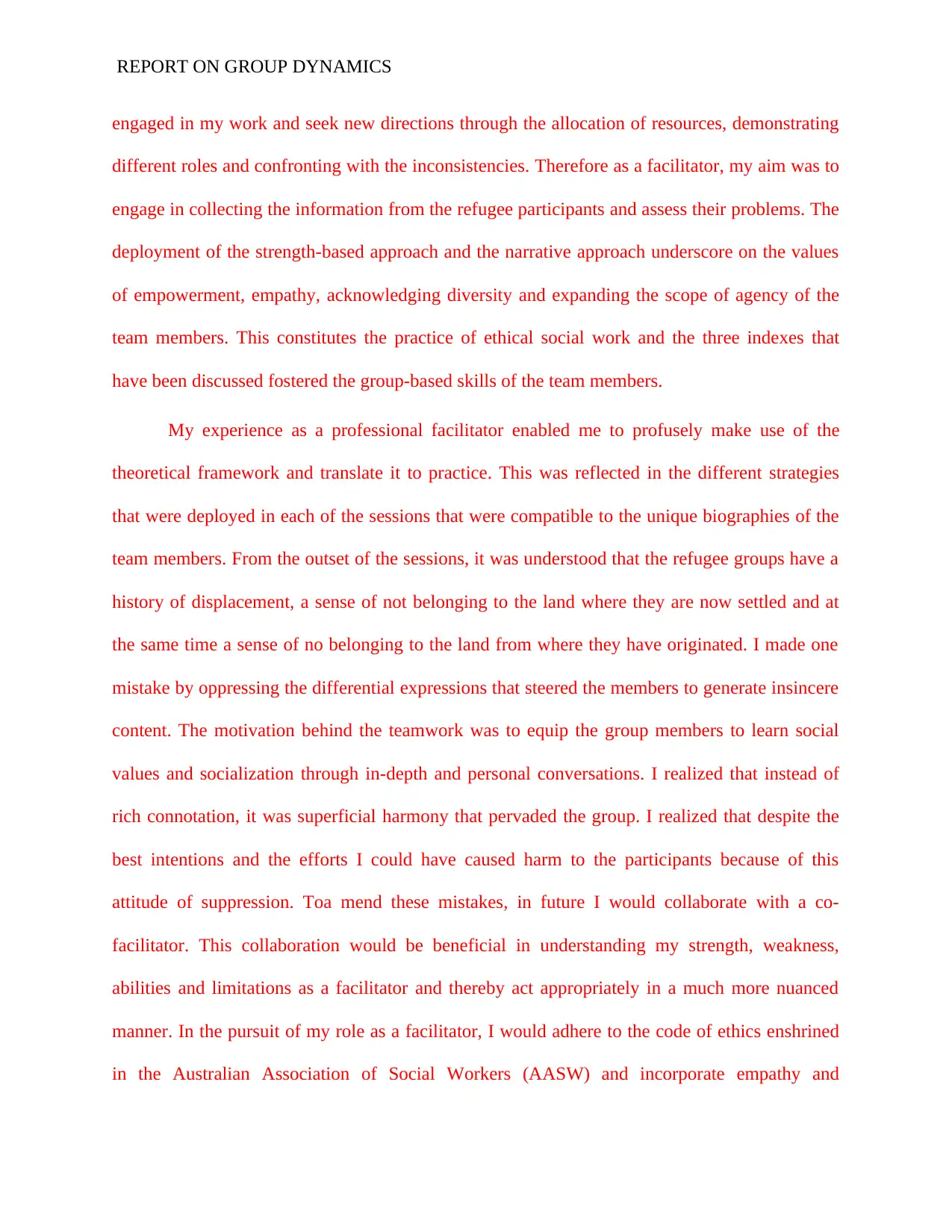
REPORT ON GROUP DYNAMICS
engaged in my work and seek new directions through the allocation of resources, demonstrating
different roles and confronting with the inconsistencies. Therefore as a facilitator, my aim was to
engage in collecting the information from the refugee participants and assess their problems. The
deployment of the strength-based approach and the narrative approach underscore on the values
of empowerment, empathy, acknowledging diversity and expanding the scope of agency of the
team members. This constitutes the practice of ethical social work and the three indexes that
have been discussed fostered the group-based skills of the team members.
My experience as a professional facilitator enabled me to profusely make use of the
theoretical framework and translate it to practice. This was reflected in the different strategies
that were deployed in each of the sessions that were compatible to the unique biographies of the
team members. From the outset of the sessions, it was understood that the refugee groups have a
history of displacement, a sense of not belonging to the land where they are now settled and at
the same time a sense of no belonging to the land from where they have originated. I made one
mistake by oppressing the differential expressions that steered the members to generate insincere
content. The motivation behind the teamwork was to equip the group members to learn social
values and socialization through in-depth and personal conversations. I realized that instead of
rich connotation, it was superficial harmony that pervaded the group. I realized that despite the
best intentions and the efforts I could have caused harm to the participants because of this
attitude of suppression. Toa mend these mistakes, in future I would collaborate with a co-
facilitator. This collaboration would be beneficial in understanding my strength, weakness,
abilities and limitations as a facilitator and thereby act appropriately in a much more nuanced
manner. In the pursuit of my role as a facilitator, I would adhere to the code of ethics enshrined
in the Australian Association of Social Workers (AASW) and incorporate empathy and
engaged in my work and seek new directions through the allocation of resources, demonstrating
different roles and confronting with the inconsistencies. Therefore as a facilitator, my aim was to
engage in collecting the information from the refugee participants and assess their problems. The
deployment of the strength-based approach and the narrative approach underscore on the values
of empowerment, empathy, acknowledging diversity and expanding the scope of agency of the
team members. This constitutes the practice of ethical social work and the three indexes that
have been discussed fostered the group-based skills of the team members.
My experience as a professional facilitator enabled me to profusely make use of the
theoretical framework and translate it to practice. This was reflected in the different strategies
that were deployed in each of the sessions that were compatible to the unique biographies of the
team members. From the outset of the sessions, it was understood that the refugee groups have a
history of displacement, a sense of not belonging to the land where they are now settled and at
the same time a sense of no belonging to the land from where they have originated. I made one
mistake by oppressing the differential expressions that steered the members to generate insincere
content. The motivation behind the teamwork was to equip the group members to learn social
values and socialization through in-depth and personal conversations. I realized that instead of
rich connotation, it was superficial harmony that pervaded the group. I realized that despite the
best intentions and the efforts I could have caused harm to the participants because of this
attitude of suppression. Toa mend these mistakes, in future I would collaborate with a co-
facilitator. This collaboration would be beneficial in understanding my strength, weakness,
abilities and limitations as a facilitator and thereby act appropriately in a much more nuanced
manner. In the pursuit of my role as a facilitator, I would adhere to the code of ethics enshrined
in the Australian Association of Social Workers (AASW) and incorporate empathy and
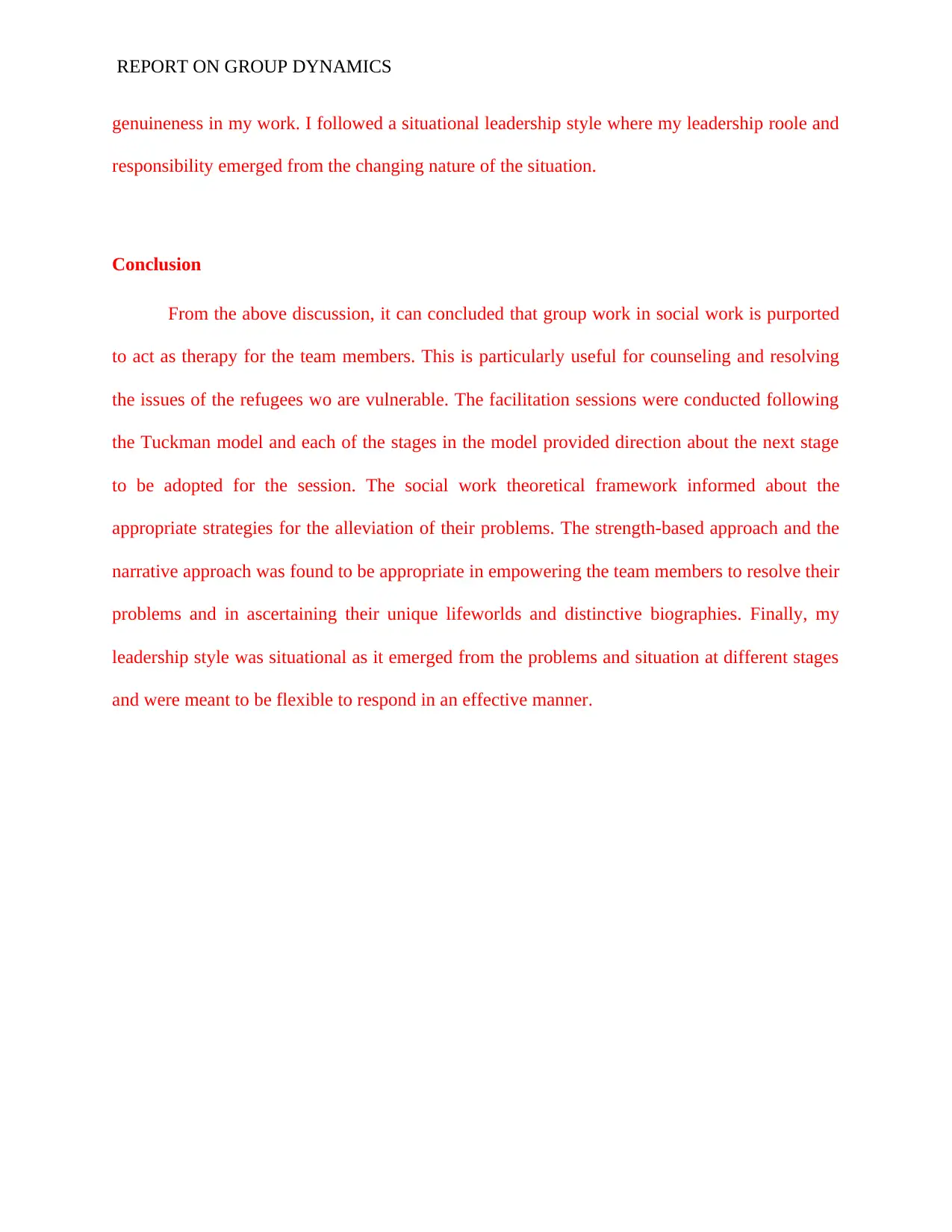
REPORT ON GROUP DYNAMICS
genuineness in my work. I followed a situational leadership style where my leadership roole and
responsibility emerged from the changing nature of the situation.
Conclusion
From the above discussion, it can concluded that group work in social work is purported
to act as therapy for the team members. This is particularly useful for counseling and resolving
the issues of the refugees wo are vulnerable. The facilitation sessions were conducted following
the Tuckman model and each of the stages in the model provided direction about the next stage
to be adopted for the session. The social work theoretical framework informed about the
appropriate strategies for the alleviation of their problems. The strength-based approach and the
narrative approach was found to be appropriate in empowering the team members to resolve their
problems and in ascertaining their unique lifeworlds and distinctive biographies. Finally, my
leadership style was situational as it emerged from the problems and situation at different stages
and were meant to be flexible to respond in an effective manner.
genuineness in my work. I followed a situational leadership style where my leadership roole and
responsibility emerged from the changing nature of the situation.
Conclusion
From the above discussion, it can concluded that group work in social work is purported
to act as therapy for the team members. This is particularly useful for counseling and resolving
the issues of the refugees wo are vulnerable. The facilitation sessions were conducted following
the Tuckman model and each of the stages in the model provided direction about the next stage
to be adopted for the session. The social work theoretical framework informed about the
appropriate strategies for the alleviation of their problems. The strength-based approach and the
narrative approach was found to be appropriate in empowering the team members to resolve their
problems and in ascertaining their unique lifeworlds and distinctive biographies. Finally, my
leadership style was situational as it emerged from the problems and situation at different stages
and were meant to be flexible to respond in an effective manner.
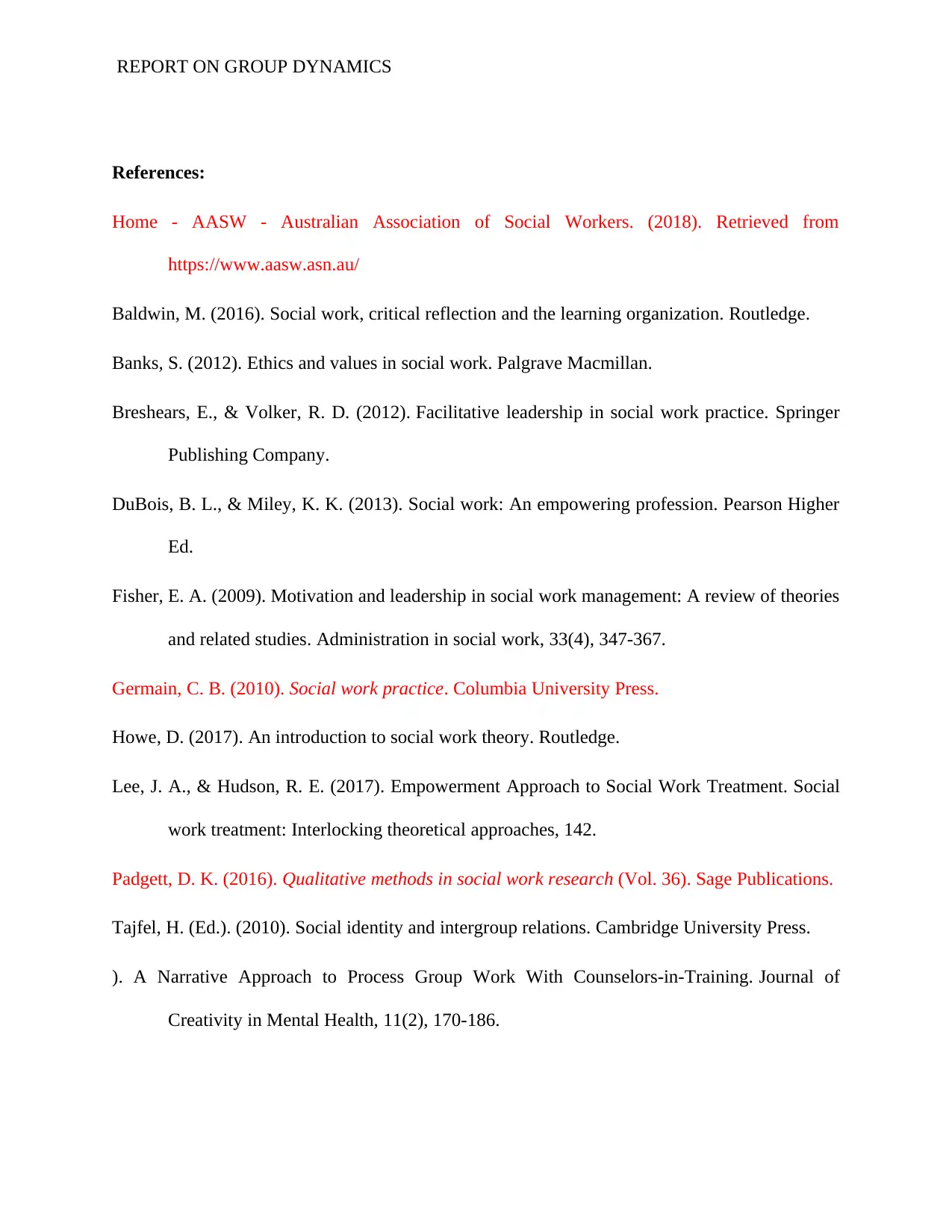
REPORT ON GROUP DYNAMICS
References:
Home - AASW - Australian Association of Social Workers. (2018). Retrieved from
https://www.aasw.asn.au/
Baldwin, M. (2016). Social work, critical reflection and the learning organization. Routledge.
Banks, S. (2012). Ethics and values in social work. Palgrave Macmillan.
Breshears, E., & Volker, R. D. (2012). Facilitative leadership in social work practice. Springer
Publishing Company.
DuBois, B. L., & Miley, K. K. (2013). Social work: An empowering profession. Pearson Higher
Ed.
Fisher, E. A. (2009). Motivation and leadership in social work management: A review of theories
and related studies. Administration in social work, 33(4), 347-367.
Germain, C. B. (2010). Social work practice. Columbia University Press.
Howe, D. (2017). An introduction to social work theory. Routledge.
Lee, J. A., & Hudson, R. E. (2017). Empowerment Approach to Social Work Treatment. Social
work treatment: Interlocking theoretical approaches, 142.
Padgett, D. K. (2016). Qualitative methods in social work research (Vol. 36). Sage Publications.
Tajfel, H. (Ed.). (2010). Social identity and intergroup relations. Cambridge University Press.
). A Narrative Approach to Process Group Work With Counselors-in-Training. Journal of
Creativity in Mental Health, 11(2), 170-186.
References:
Home - AASW - Australian Association of Social Workers. (2018). Retrieved from
https://www.aasw.asn.au/
Baldwin, M. (2016). Social work, critical reflection and the learning organization. Routledge.
Banks, S. (2012). Ethics and values in social work. Palgrave Macmillan.
Breshears, E., & Volker, R. D. (2012). Facilitative leadership in social work practice. Springer
Publishing Company.
DuBois, B. L., & Miley, K. K. (2013). Social work: An empowering profession. Pearson Higher
Ed.
Fisher, E. A. (2009). Motivation and leadership in social work management: A review of theories
and related studies. Administration in social work, 33(4), 347-367.
Germain, C. B. (2010). Social work practice. Columbia University Press.
Howe, D. (2017). An introduction to social work theory. Routledge.
Lee, J. A., & Hudson, R. E. (2017). Empowerment Approach to Social Work Treatment. Social
work treatment: Interlocking theoretical approaches, 142.
Padgett, D. K. (2016). Qualitative methods in social work research (Vol. 36). Sage Publications.
Tajfel, H. (Ed.). (2010). Social identity and intergroup relations. Cambridge University Press.
). A Narrative Approach to Process Group Work With Counselors-in-Training. Journal of
Creativity in Mental Health, 11(2), 170-186.
Secure Best Marks with AI Grader
Need help grading? Try our AI Grader for instant feedback on your assignments.
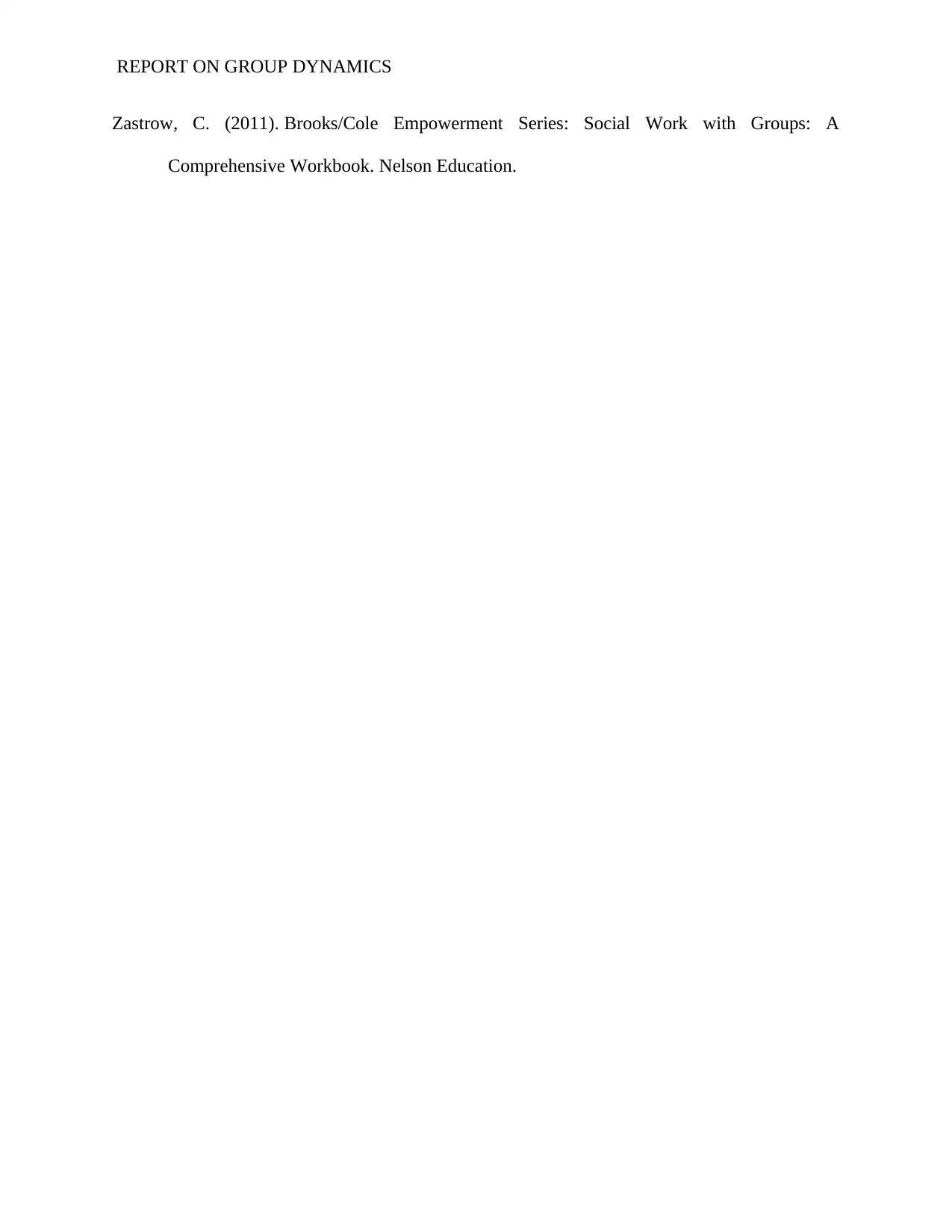
REPORT ON GROUP DYNAMICS
Zastrow, C. (2011). Brooks/Cole Empowerment Series: Social Work with Groups: A
Comprehensive Workbook. Nelson Education.
Zastrow, C. (2011). Brooks/Cole Empowerment Series: Social Work with Groups: A
Comprehensive Workbook. Nelson Education.
1 out of 11
Related Documents
Your All-in-One AI-Powered Toolkit for Academic Success.
+13062052269
info@desklib.com
Available 24*7 on WhatsApp / Email
![[object Object]](/_next/static/media/star-bottom.7253800d.svg)
Unlock your academic potential
© 2024 | Zucol Services PVT LTD | All rights reserved.





